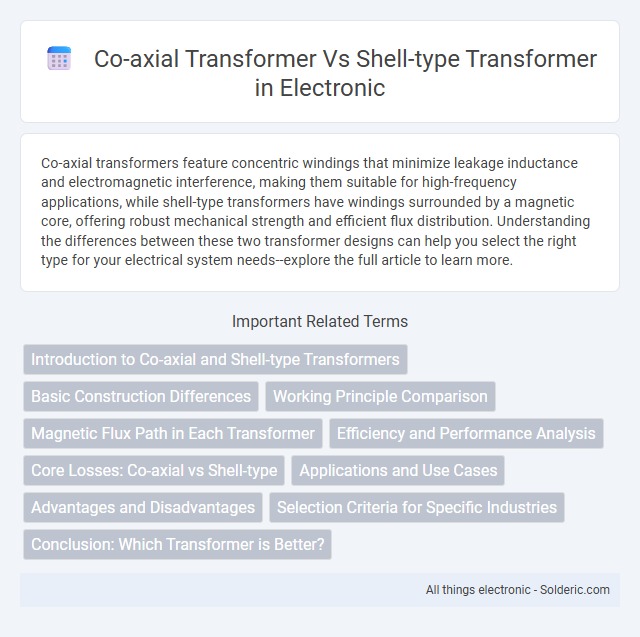Co-axial transformers feature concentric windings that minimize leakage inductance and electromagnetic interference, making them suitable for high-frequency applications, while shell-type transformers have windings surrounded by a magnetic core, offering robust mechanical strength and efficient flux distribution. Understanding the differences between these two transformer designs can help you select the right type for your electrical system needs--explore the full article to learn more.
Comparison Table
| Feature | Co-Axial Transformer | Shell-Type Transformer |
|---|---|---|
| Core Structure | Concentric cylindrical cores around the winding | Core surrounds windings on multiple sides |
| Magnetic Flux Path | Flux flows axially along the core | Flux flows through the shell enclosing the windings |
| Leakage Reactance | Lower leakage reactance | Moderate leakage reactance |
| Mechanical Strength | High mechanical strength due to cylindrical shape | Robust but comparatively less |
| Cooling Efficiency | Good due to cylindrical design | Effective cooling via core and windings design |
| Applications | High-frequency transformers, audio transformers | Power transformers, distribution transformers |
| Cost | Higher manufacturing cost | Generally cost-effective |
Introduction to Co-axial and Shell-type Transformers
Co-axial transformers feature a cylindrical core surrounded by windings, offering reduced leakage inductance and excellent high-frequency performance ideal for RF applications. Shell-type transformers have a core that encases the windings, providing superior magnetic flux containment and enhanced mechanical strength, commonly used in power supply and audio systems. Your choice between these transformers depends on frequency range, efficiency, and application-specific requirements.
Basic Construction Differences
The basic construction of a co-axial transformer features a cylindrical core with windings arranged concentrically, allowing efficient magnetic flux linkage and reduced leakage inductance. In contrast, shell-type transformers have a core that surrounds the windings on multiple sides, providing better mechanical protection and enhanced magnetic flux containment. Your choice between these types depends on factors like size constraints, efficiency requirements, and application-specific needs.
Working Principle Comparison
Co-axial transformers operate by using a central conductor surrounded concentrically by a magnetic core and winding, which enhances magnetic coupling and reduces leakage inductance, leading to efficient high-frequency energy transfer. Shell-type transformers have their windings placed on a central limb of a laminated iron core, providing superior mechanical strength and better magnetic flux containment, resulting in low core losses and improved stability under load. Your choice between these depends on the application frequency and magnetic flux management needs, as co-axial transformers excel in high-frequency domains, while shell-type transformers are preferred for power distribution and regulation.
Magnetic Flux Path in Each Transformer
The magnetic flux path in a co-axial transformer is designed with the primary and secondary windings wound concentrically around a common core, enabling magnetic flux to flow radially and symmetrically between them. In contrast, a shell-type transformer has its windings encased within a laminated steel core, where the magnetic flux path is predominantly linear, flowing through the core limbs and yokes, which surround the coil. The co-axial design minimizes leakage flux and improves coupling efficiency, whereas the shell-type core offers superior flux containment and mechanical protection.
Efficiency and Performance Analysis
Co-axial transformers typically offer superior electromagnetic compatibility and reduced leakage inductance, enhancing overall efficiency compared to shell-type transformers, which are often favored for their robust construction and ease of cooling. Your choice between these transformer types should consider the load conditions and frequency range, as co-axial designs excel in high-frequency applications and shell-type transformers maintain consistent performance under variable loads. Performance analysis reveals that co-axial transformers minimize energy losses in precision equipment, while shell-type transformers provide reliable efficiency in power distribution scenarios.
Core Losses: Co-axial vs Shell-type
Co-axial transformers typically exhibit lower core losses due to their symmetrical magnetic flux distribution, which minimizes hysteresis and eddy current effects. Shell-type transformers, with their overlapping core limbs, may experience higher core losses but provide better mechanical strength and noise reduction. Optimizing core materials and lamination thickness can significantly impact loss performance in both transformer types.
Applications and Use Cases
Co-axial transformers are primarily used in radio frequency (RF) and microwave applications due to their superior high-frequency performance and impedance matching capabilities. Shell-type transformers excel in power distribution and industrial applications, offering robust mechanical strength and efficient handling of high voltages and currents. Both transformer types optimize performance in their specific domains, with co-axial transformers favored in communication systems and shell-type transformers prevalent in electrical power systems.
Advantages and Disadvantages
Co-axial transformers offer advantages such as better high-frequency performance and reduced electromagnetic interference, making them ideal for specialized communication equipment. Shell-type transformers provide superior mechanical strength, higher efficiency, and better short-circuit protection, which benefits power distribution and industrial applications. Your choice depends on the specific requirements for frequency, durability, and application environment.
Selection Criteria for Specific Industries
Co-axial transformers are ideal for industries requiring high-voltage insulation and compact design, such as telecommunications and aerospace, due to their ability to minimize electromagnetic interference. Shell-type transformers offer superior mechanical strength and better short-circuit protection, making them suitable for heavy industrial applications like steel manufacturing and power plants. Your choice should consider factors like environmental conditions, space constraints, and electrical load to ensure optimal performance and reliability.
Conclusion: Which Transformer is Better?
Co-axial transformers offer superior electromagnetic interference shielding and compact design, making them ideal for high-frequency and sensitive electronic applications. Shell-type transformers provide enhanced mechanical strength, better thermal performance, and efficient magnetic flux distribution, suitable for heavy industrial use. Your choice depends on application requirements: co-axial transformers excel in precision and noise reduction, while shell-type transformers deliver robustness and thermal reliability.
co-axial transformer vs shell-type transformer Infographic

 solderic.com
solderic.com